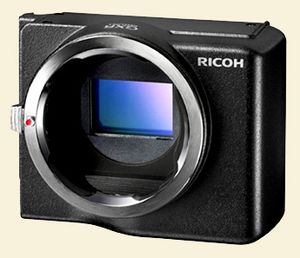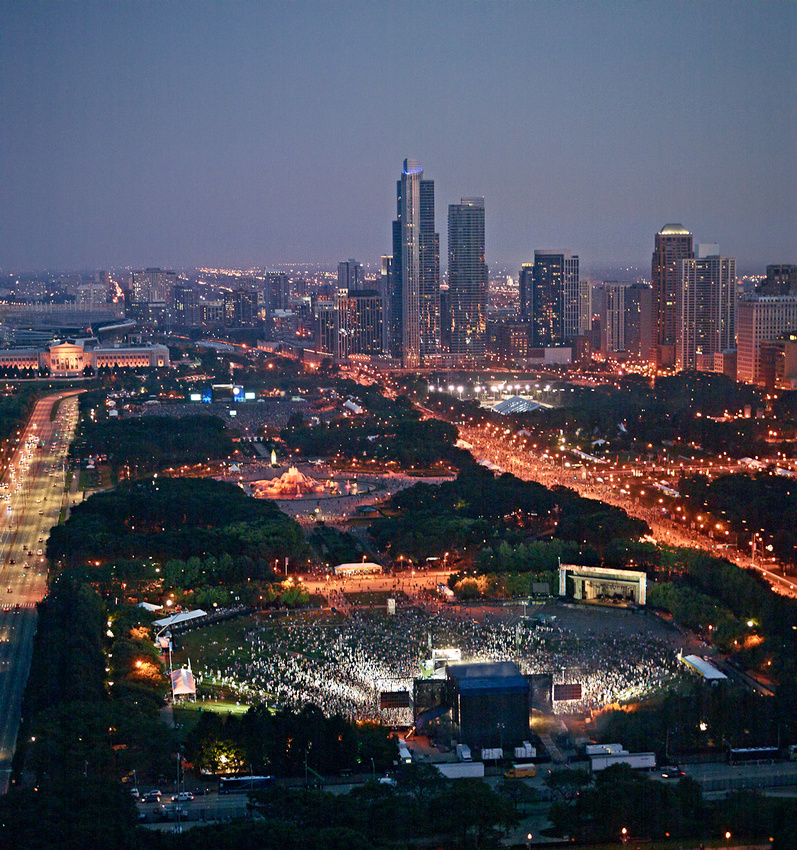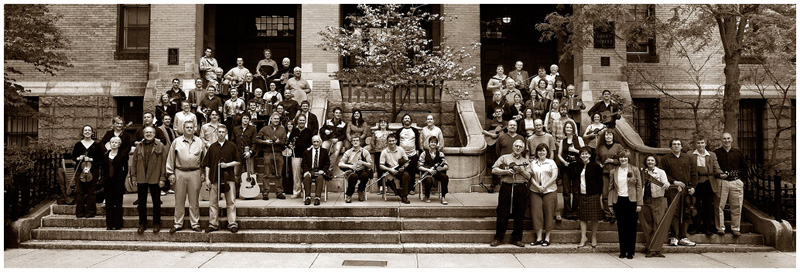Farm children in tymes gone by knew that a chicken with its head chopped off and destined for the dinner pot would run around for a bit before it dropped—propelled by reflex and a sort of muscle memory, I suppose. Nowadays, it's just an expression: I've never witnessed a chicken beheading myself. Not the sort of thing you'd see in a petting zoo, or the rustic spot with the cornstalk maze where we buy our pumpkin in the fall.
The industrial equivalent will probably pertain at the newly formed Ricoh-Pentax, or whatever it's to be called (do we know yet? I've been away). Plans set in motion before the merger will continue of their own inertia for a while yet. It's not too difficult to deduce that the Pentax Q system and the Ricoh GXR, while incompatible with each other, overlap into the same market space somewhat. The future of both niche products now seems even more iffy than they did before.
 While I was away, the Ricoh "M Module" for the GXR was introduced. As regular readers know, I've been using the GXR recently (although I didn't take it on vacation), and I find it both fundamentally unrecommendable and also in many ways a really fun, funky, appealling little camera—an appealing little camera that I actually like quite a bit more than run-o'-the-mill cookie-cutter offerings that are undeniably more mainstream. (Maybe I'm jaded.)
While I was away, the Ricoh "M Module" for the GXR was introduced. As regular readers know, I've been using the GXR recently (although I didn't take it on vacation), and I find it both fundamentally unrecommendable and also in many ways a really fun, funky, appealling little camera—an appealing little camera that I actually like quite a bit more than run-o'-the-mill cookie-cutter offerings that are undeniably more mainstream. (Maybe I'm jaded.)
Once you add to the mix the fundamentally uncertain future of the GXR because of the merger, the GXR and M Module becomes something you'd almost have to be crazy to invest in (as a user system, I mean—it's not hard to imagine that it might become highly collectible one day)...but what a proof of concept, huh? The GXR / M Module might never be more than the tiniest of blips on the sales charts, but I think we might well be seeing a landmark in the history of camera development. The very idea of separating the body shell from the sensor from the lens is something that camera nuts have been daydreaming about since before we were quite sure what a "pixel" was. It means you can keep your body and your lenses and upgrade just the sensor as the march of digital technology relentlessly obsoletes your old one. That's very, very cool, and very appealing to many people who are getting very tired of tossing clean, working cameras on to the towering scrap heap of yesterday's news.
Moreover, it's doubtless going to be something that a few lucky, intrepid, or monied hobbyists are going to have a whale of a lot of fun with. Doubtless we'll hear more from the Petulant, the Truculent, and the Naysayers than from those who will actually use one, but fun is fun, and the M Module sure looks like it's gonna be.
Meanwhile, for the rest of us, just thinking about what might happen when the engineers of the Q system and the engineers of the GXR put their heads together is going to be tantalizing indeed. It might be a success and it might be a train wreck, but it sure looks like it's gonna be interesting.
Mike
Send this post to a friend
Please help support TOP by patronizing our sponsors B&H Photo and Amazon
Note: Links in this post may be to our affiliates; sales through affiliate links may benefit this site. More...
Original contents copyright 2011 by Michael C. Johnston and/or the bylined author. All Rights Reserved.
Featured (partial) Comment by Andrew: "I don't think we've heard the 'fundamentally unrecommendable' aspect of your GXR experience. Very curious to hear."
Mike replies: Well, it's not a big secret—it's essentially prima facie, something anybody can see when looking at the product line. I wrote about it here. The basic problem is redundancy. If you want a set of lenses all with the same sensor, you have to repurchase the sensor for each new lens you buy.
The M Module is actually an excellent application of the concomittant benefits of the GXR approach. A B&W sensor would be another good application. A small telephoto lens based on a small sensor (giving more effective "reach") might be another.
The lack of mix-and-match options might show up in other ways in the future, as new products are introduced. For instance, let's say I want a B&W-only module. And let's say Ricoh introduces one, with a full-frame size sensor but a very large pixel pitch that gives it a very distinctive "look." But the module comes with, say, a 35mm-equivalent lens. So then people say they also would like the same sensor with a 50mm-e macro lens, so Ricoh introduces that. But perhaps you already have the 50mm-e Macro lens with the APS-C color sensor. Again, you feel you're buying twice what you should have only had to buy once.
A system with a split shell/sensor/lens brings up other problems (for instance, would all the lenses be designed to cover the largest of the sensor sizes? How then do you make wide-angles that work as such on very small sensors? Etc.), but it seems like a real step towards more system flexibility rather than less.
Featured Comment by Robert Roaldi: "On the 'photo-interweb,' equipment choice is usually discussed on the basis of 'system investment,' i.e., future compatibility, replication avoidance, etc. This strikes me as how a committee full of MBAs at a corporation selects their cubicle furniture 'system.'
"The longest running example of this is the advice to newbies, looking for camera gear for the first time, to stick to Canon/Nikon because they have the most extensive systems and (or) more rental houses carry their lenses. As a rough percentage, I'd guess that the number of SLR and DSLR purchasers to whom this made a real-life difference probably rounds to zero (in first order).
"The forums are full of people changing systems (or maybe just saying they do) at the drop of a hat. Second-hand sites and stores are full of great deals, there's no shortage of people selling stuff.
"Looking back, instead of guessing forward, how many people bought equipment this rationally? The GXR 'system' is quirky and fun and you like using it; 99% of the time, that's probably enough.
"I started with screw-mount Pentaxes and now mostly use Olympus 4/3 gear. To date, I haven't missed those rental tilt-shift or 600mm Canon/Nikon lenses one bit.
"I am certain that there are plenty of people to whom these things really do matter, and they know who they are. To the rest of the camera buying public, it shouldn't matter in the least."
Featured Comment by Ctein: "Mike, I think that most of what the two of us wrote nearly two years ago still applies."
Featured Comment by Steve Rosenblum: "Hmm.... This doesn't seem as complicated to me. I have a number of M mount lenses in my cabinet—a couple of Leica, Minolta CLE, and a bunch of Cosina-Voigtlander lenses. They are very nice lenses both optically and from the standpoint of compact size/weight. At the moment I don't have any digital way of using them short of scanning film. The micro 4/3 route isn't very appealing to me because of the 2X crop factor; even my wide lenses end up normal or short telephotos. So the prospect of buying this module with the GXR body at a fraction of the cost of the Leica M9 (or a used M8 for that matter) has a lot of appeal. I really don't care if the other modules have limited usefulness; having the ability to use my M mount lenses in an affordable manner justifies the purchase. The fact that Ricoh has been way ahead of the curve on making ergonomically usable cameras is icing on the cake."
Featured Comment by John Camp: "I had a bunch of M lenses at one time, and bought an adapter for my Micro 4/3 camera, and in some ways it worked better than an M8 (at least with the Noctilux, 90mm, and 135mm—you could actually focus them). But, in general, it was a pain in the ass, and I didn't really see much difference with the Leica lenses compared to the Panasonics, except that the Panasonics had autofocus and full electronic communication with the body. So, I eventually sold all the M lenses (I'd already sold the M8.) If I'd held onto them long enough to try the Ricoh, I suspect my reaction would be the same—I'd try it, then I'd sell the lenses.
"We all know that there are large numbers of photographers, however good their images are or are not, who also enjoy the techological/mechanical aspects of photography, and I think the Ricoh might be their kind of camera. For people who are mostly interested in images, not so much. The fact is, there are much better cameras and systems out there, at not much more cost.
"If Ricoh wanted to do this at all, it should have done the entire system like it did the M module—break it into three pieces, so you could replace only a sensor, or only a lens. That would be even more interesting for the techno-enthusiasts....
"By the way, I checked KEH Camera, and the cheapest modern Leica 50mm they have, used, in EX condition (as opposed to ugly or bargain) costs more than $2,000...do you really want to spend that much just to strap an M lens on the front of a Ricoh? To me, that does not compute."






